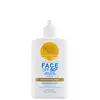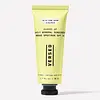What's inside
What's inside
 Key Ingredients
Key Ingredients

 Benefits
Benefits

 Concerns
Concerns

 Ingredients Side-by-side
Ingredients Side-by-side

Water
Skin ConditioningHomosalate
Skin ConditioningOctocrylene
UV AbsorberDibutyl Adipate
EmollientButyl Methoxydibenzoylmethane
UV AbsorberMethylene Bis-Benzotriazolyl Tetramethylbutylphenol
UV FilterButylene Glycol
HumectantC12-15 Alkyl Benzoate
AntimicrobialSilica
AbrasivePolyglyceryl-3 Methylglucose Distearate
EmulsifyingBis-Ethylhexyloxyphenol Methoxyphenyl Triazine
Skin ConditioningDiethylamino Hydroxybenzoyl Hexyl Benzoate
UV FilterTapioca Starch
Glyceryl Stearate
EmollientPhenoxyethanol
PreservativeSaccharide Isomerate
HumectantPotassium Cetyl Phosphate
EmulsifyingDecyl Glucoside
CleansingAcrylates Copolymer
Caprylyl Glycol
Emollient1,2-Hexanediol
Skin ConditioningTriethanolamine
BufferingHydroxyacetophenone
AntioxidantCI 77891
Cosmetic ColorantCI 77491
Cosmetic ColorantCI 77492
Cosmetic ColorantPolymethylsilsesquioxane
Disodium EDTA
Tocopheryl Acetate
AntioxidantCI 77499
Cosmetic ColorantDecylene Glycol
Skin ConditioningPropylene Glycol
HumectantXanthan Gum
EmulsifyingCitric Acid
BufferingSodium Citrate
BufferingAlumina
AbrasiveWater, Homosalate, Octocrylene, Dibutyl Adipate, Butyl Methoxydibenzoylmethane, Methylene Bis-Benzotriazolyl Tetramethylbutylphenol, Butylene Glycol, C12-15 Alkyl Benzoate, Silica, Polyglyceryl-3 Methylglucose Distearate, Bis-Ethylhexyloxyphenol Methoxyphenyl Triazine, Diethylamino Hydroxybenzoyl Hexyl Benzoate, Tapioca Starch, Glyceryl Stearate, Phenoxyethanol, Saccharide Isomerate, Potassium Cetyl Phosphate, Decyl Glucoside, Acrylates Copolymer, Caprylyl Glycol, 1,2-Hexanediol, Triethanolamine, Hydroxyacetophenone, CI 77891, CI 77491, CI 77492, Polymethylsilsesquioxane, Disodium EDTA, Tocopheryl Acetate, CI 77499, Decylene Glycol, Propylene Glycol, Xanthan Gum, Citric Acid, Sodium Citrate, Alumina
Zinc Oxide 15.2%
Cosmetic ColorantWater
Skin ConditioningButyloctyl Salicylate
Skin ConditioningIsodecyl Neopentanoate
EmollientCalcium Sodium Borosilicate
Diheptyl Succinate
EmollientC18-21 Alkane
SolventErythritol
HumectantCetearyl Alcohol
EmollientSodium Stearoyl Glutamate
CleansingCapryloyl Glycerin/Sebacic Acid Copolymer
Skin ConditioningPropanediol
SolventArachidyl Alcohol
EmollientGlycerin
HumectantPyrus Malus Fruit Extract
Skin ConditioningCaprylic/Capric Triglyceride
MaskingTocopherol
AntioxidantCaprylyl Glycol
EmollientCoco-Glucoside
CleansingEthyl Ferulate
AntioxidantBehenyl Alcohol
EmollientCetyl Alcohol
EmollientArachidyl Glucoside
EmulsifyingBisabolol
MaskingPolyhydroxystearic Acid
EmulsifyingCitric Acid
BufferingSodium Gluconate
Skin ConditioningXanthan Gum
EmulsifyingOctyldodecyl Oleate
EmollientCaprylhydroxamic Acid
Hydrolyzed Jojoba Esters
Skin ConditioningSodium Hyaluronate
HumectantCrithmum Maritimum Extract
Skin ConditioningMaltodextrin
AbsorbentMoringa Oleifera Seed Extract
Skin ConditioningAloe Barbadensis Leaf
MaskingIron Oxides
CI 77491
Cosmetic ColorantZinc Oxide 15.2%, Water, Butyloctyl Salicylate, Isodecyl Neopentanoate, Calcium Sodium Borosilicate, Diheptyl Succinate, C18-21 Alkane, Erythritol, Cetearyl Alcohol, Sodium Stearoyl Glutamate, Capryloyl Glycerin/Sebacic Acid Copolymer, Propanediol, Arachidyl Alcohol, Glycerin, Pyrus Malus Fruit Extract, Caprylic/Capric Triglyceride, Tocopherol, Caprylyl Glycol, Coco-Glucoside, Ethyl Ferulate, Behenyl Alcohol, Cetyl Alcohol, Arachidyl Glucoside, Bisabolol, Polyhydroxystearic Acid, Citric Acid, Sodium Gluconate, Xanthan Gum, Octyldodecyl Oleate, Caprylhydroxamic Acid, Hydrolyzed Jojoba Esters, Sodium Hyaluronate, Crithmum Maritimum Extract, Maltodextrin, Moringa Oleifera Seed Extract, Aloe Barbadensis Leaf, Iron Oxides, CI 77491
 Reviews
Reviews

Ingredients Explained
These ingredients are found in both products.
Ingredients higher up in an ingredient list are typically present in a larger amount.
Caprylyl Glycol is a humectant and emollient, meaning it attracts and preserves moisture.
It is a common ingredient in many products, especially those designed to hydrate skin. The primary benefits are retaining moisture, skin softening, and promoting a healthy skin barrier.
Though Caprylyl Glycol is an alcohol derived from fatty acids, it is not the kind that can dry out skin.
This ingredient is also used as a preservative to extend the life of products. It has slight antimicrobial properties.
Learn more about Caprylyl GlycolCi 77491 is also hydrated iron III oxide. It's sole purpose is to give a red/pink hue to products.
Iron III oxides are classified as inorganic chemicals for coloring.
Synthetically created Ci 77491 is considered safer than those naturally found. This is because the synthetically created version may contain less impurities. Iron oxides are generally non-toxic and non-allergenic.
Learn more about CI 77491Citric Acid is an alpha hydroxy acid (AHA) naturally found in citrus fruits like oranges, lemons, and limes.
Like other AHAs, citric acid can exfoliate skin by breaking down the bonds that hold dead skin cells together. This helps reveal smoother and brighter skin underneath.
However, this exfoliating effect only happens at high concentrations (20%) which can be hard to find in cosmetic products.
Due to this, citric acid is usually included in small amounts as a pH adjuster. This helps keep products slightly more acidic and compatible with skin's natural pH.
In skincare formulas, citric acid can:
While it can provide some skin benefits, research shows lactic acid and glycolic acid are generally more effective and less irritating exfoliants.
Most citric acid used in skincare today is made by fermenting sugars (usually from molasses). This synthetic version is identical to the natural citrus form but easier to stabilize and use in formulations.
Read more about some other popular AHA's here:
Learn more about Citric AcidWater. It's the most common cosmetic ingredient of all. You'll usually see it at the top of ingredient lists, meaning that it makes up the largest part of the product.
So why is it so popular? Water most often acts as a solvent - this means that it helps dissolve other ingredients into the formulation.
You'll also recognize water as that liquid we all need to stay alive. If you see this, drink a glass of water. Stay hydrated!
Learn more about WaterXanthan gum is used as a stabilizer and thickener within cosmetic products. It helps give products a sticky, thick feeling - preventing them from being too runny.
On the technical side of things, xanthan gum is a polysaccharide - a combination consisting of multiple sugar molecules bonded together.
Xanthan gum is a pretty common and great ingredient. It is a natural, non-toxic, non-irritating ingredient that is also commonly used in food products.
Learn more about Xanthan Gum